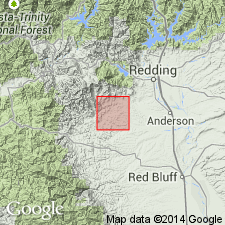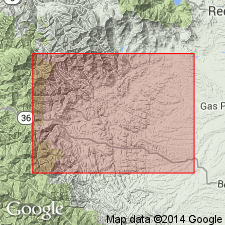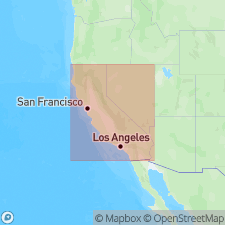
- Usage in publication:
-
- Huling tongue
- Modifications:
-
- Named
- Dominant lithology:
-
- Graywacke
- Mudstone
- Conglomerate
- AAPG geologic province:
-
- Sacramento basin
Summary:
Named for exposures along Huling Creek, Shasta Co, CA. Is unit in Ono formation (new). Composed of mostly graywacke; mudstone and thick extremely lenticular conglomerate units interbedded in lower part. Upper 500 ft of tongue contains GABBIOCERAS WINTUNIUM Zone, Horsetown Stage fossils. Lower contact of tongue usually very distinct; lower beds form north-facing cuesta-like escarpment overlooking less resistant mudstone of lower part of Ono formation. Underlies mudstones with gradational contact. Is Late Cretaceous age.
Source: GNU records (USGS DDS-6; Menlo GNULEX).

- Usage in publication:
-
- Huling Sandstone Member
- Modifications:
-
- Revised
- Areal extent
- AAPG geologic province:
-
- Sacramento basin
Summary:
Upper 850 ft of Huling "tongue" of Ono Formation (Murphy, 1956) is raised in rank as Huling Sandstone Member and assigned to Budden Canyon Formation (new). Mudstone and conglomerate beds of original "tongue" are excluded since they may be more related lithologically, spatially, and temporally to Roaring River or Chickabally Members. Recognized as far south as Big Salt Creek in northernmost Tehama Co, CA.
Source: GNU records (USGS DDS-6; Menlo GNULEX).

- Usage in publication:
-
- Huling Member
- Modifications:
-
- Redescribed
- Dominant lithology:
-
- Sandstone
- Conglomerate
- AAPG geologic province:
-
- Sacramento basin
Summary:
Huling Sandstone Member (Murphy, 1964) is redescribed as Huling Member of Budden Canyon Formation. At type locality [on Huling Creek] thickness is 800 ft. Consists of basal cobble conglomerate (10 ft thick) and overlying resistant massive-to-thick bedded graywacke sandstone. Overlies Roaring River Member (Budden Canyon Formation). Underlies Aiken Member (new) (Budden Canyon Formation)
Source: GNU records (USGS DDS-6; Menlo GNULEX).
For more information, please contact Nancy Stamm, Geologic Names Committee Secretary.
Asterisk (*) indicates published by U.S. Geological Survey authors.
"No current usage" (†) implies that a name has been abandoned or has fallen into disuse. Former usage and, if known, replacement name given in parentheses ( ).
Slash (/) indicates name conflicts with nomenclatural guidelines (CSN, 1933; ACSN, 1961, 1970; NACSN, 1983, 2005, 2021). May be explained within brackets ([ ]).

